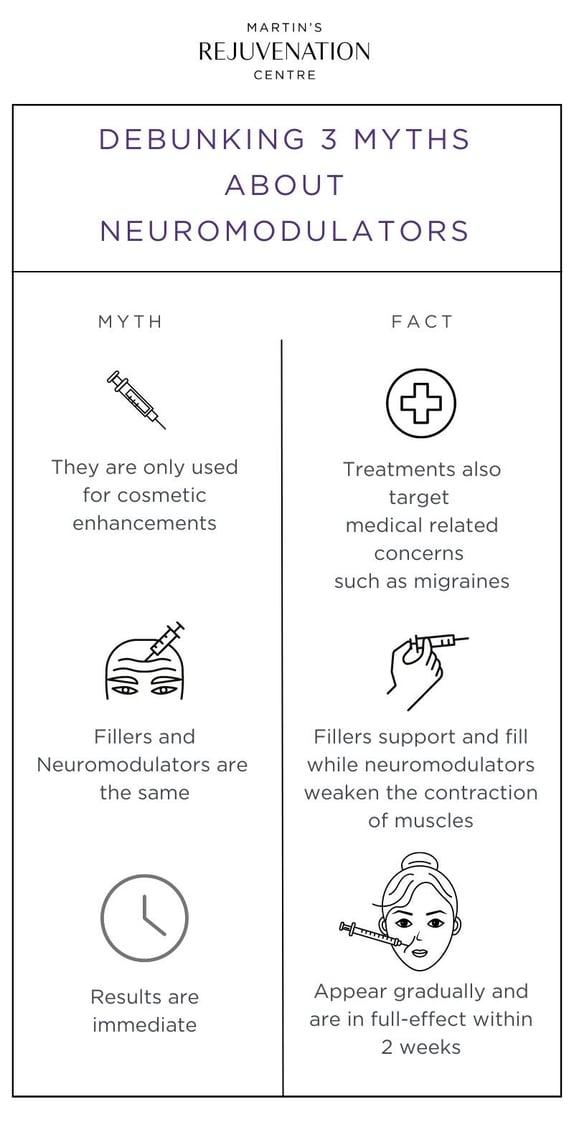Learn the Science Behind Botox with Martin's Rejuvenation
As we age, our skin loses its elasticity, slows down collagen production, and we start noticing volume loss. When this happens, we consider using more than sunscreen, sheet masks, and serums to keep our skin youthful.
Some might start looking into non-invasive treatment options to slow the aging process. This can be as simple as medical-grade facials or more complex such as skin tightening options or injectables.
If you've been thinking about Botox treatments, then keep reading.
In this blog post, our team at Martin's Rejuvenation will explain everything you need to know about Botox: What really is it? How does it work? Is it right for my skin concerns? What is the difference between Botox and dermal fillers?
What is a Neuromodulator, a.k.a Botox, and How Does it Work?
Neuromodulators are protein substances that block neurotransmitter activity in a localized area. The most well-known class of neuromodulators is botulinum toxin, commonly referred to as Botox, which has become the catch-all word for neuromodulators and injectable treatments.
When injected into specific muscles, Botox blocks the release of a neurotransmitter called acetylcholine, which is responsible for signalling muscle contraction. By inhibiting muscle contractions, Botox can temporarily relax the targeted muscles, reducing the appearance of wrinkles and fine lines on the face.
The repetition of motion on our faces turns dynamic wrinkles into static lines you see on your face. Neuromodulators are used to relax these muscle movements to prevent wrinkles from forming. Other widely known neuromodulators are Dysport, Nuceiva, and Xeomin.

What can Neuromodulators Treat?
Neuromodulators work wonders in preventing and reducing dynamic wrinkles caused by muscle movements. When it comes to facial injections, your aesthetic injector can administer these in various areas of your face, targeting the most common areas where wrinkles tend to form.
Here is a list of areas where injections are commonly administered:
- Facial Wrinkles: Neuromodulators are most commonly used to reduce the appearance of wrinkles and fine lines on the face, including:
- Forehead lines or wrinkles
- Frown lines (vertical lines between the eyebrows), also called Glabella or eleven lines.
- Crow's feet (lines around the outer corners of the eyes)
- Bunny lines (lines on the nose)
- Brow Lift: Neuromodulators can be used to lift and shape the eyebrows, providing a more youthful and refreshed appearance.
- Gummy Smile: Injections of neuromodulators can help reduce excessive gum exposure when smiling.
- Masseters: Neuromodulator injections can be used to soften the appearance of the jawline by relaxing the muscles responsible for a square or prominent jaw. This can also help with jaw clenching and teeth grinding (bruxism).
- Neck Bands: Neuromodulators may be used to reduce the prominence of vertical neck bands.
- Excessive Sweating (Hyperhidrosis): Neuromodulators can be injected into the underarms, palms, or soles to inhibit sweat gland activity and reduce excessive sweating.
- Migraine Headaches: In some cases, neuromodulators can be used as a preventive treatment for chronic migraines.
- Muscle Spasms and Movement Disorders: Certain neuromodulators are approved for treating muscle spasms and movement disorders, including cervical dystonia (involuntary neck muscle contractions), blepharospasm (eyelid twitching), and certain forms of spasticity.
Extra tip: Can't tell the difference between dermal fillers and neuromodulators? Neuromodulators treat dynamic lines (a.k.a expressive lines, such as crow's feet when you smile), while dermal fillers fill in static lines (visible wrinkles even when your face is at rest) and add volume to contour facial features.
Treatment Step-by-Step
Consultation
This is the first step before proceeding with injectable treatment. Each person's anatomy is different, so our injectors need to assess your area(s) of concern.
They will build an injectable treatment plan specific to your interest from there. They will also discuss realistic expectations and consider your budget and long-term goals.
Injection
Your injector will use a small syringe to inject the neuromodulator into precise areas. They will repeatedly ask you to create various emotions, such as lifting your brows to see the forehead and marking the area(s) accordingly. The injection will feel like a quick and tiny pinch and will be over before you know it!
Post Injection
It's important to note that neuromodulators are not immediately visible compared to dermal fillers. The neurotoxin takes up to 2 weeks to settle. So if you see movement four days later, this is completely normal.
2-week follow-up: We would love to see you 2 weeks post-injection to ensure everything looks great and you are satisfied with your treatment. If we need to make minor adjustments, we do so at this follow-up.
Book Your Follow-up Treatment: The neurotoxin breaks down generally in 2-4 months, 3 months being the average. Its longevity also depends on the area treated, your body's natural metabolic rate, and lifestyle.
Excited to Start Your Injectables Journey at Martin's Rejuvenation?
Our highly trained and knowledgeable aesthetic injectors are ready to help you with your next step to looking and feeling great!
At Martin's Rejuvenation, located in Barrie, Ontario, every treatment plan is personalized to your specific needs, goals, and interests. We need to take a 360° approach to every treatment plan. Because we understand that skin health is more than just the facial treatments we get.
Book a consultation today with one of our treatment designers to learn more about neuromodulators and if this is the right treatment for your skin goals!


.jpg)

